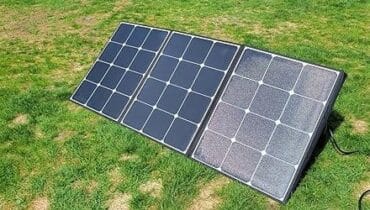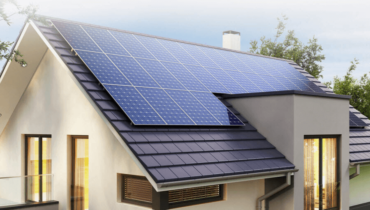If you are considering going solar, you may wonder how solar panels work. Solar panels are devices that capture sunlight and convert it into usable electricity for your home. This article explains how solar panels work, what they are made of, and how they convert sunlight into electricity.
Table of Contents
What are solar panels?
Solar panels are devices that capture sunlight and convert it into electricity. They are made up of photovoltaic cells that contain semiconductor materials, usually made of silicon, which convert sunlight into direct current (DC) electricity.
How solar panels are made?
This heading refers to the manufacturing process of solar panels. Solar panels are made up of several layers of materials, including silicon cells, glass, and metal frames. The process of making solar panels involves several steps, including slicing the silicon cells, doping, and assembling the cells into modules.
The photovoltaic effect
Solar panels work on the principle of the photovoltaic effect. The photovoltaic effect refers to the process by which solar cells convert sunlight into electricity. When sunlight hits a solar cell, it excites the electrons in the silicon atoms and knocks them loose from their atoms. These free electrons are then captured and channeled through the silicon cells, creating an electrical current.
Alternatives to silicon solar cells
There are alternative materials to silicon solar cells such as cadmium telluride, copper indium gallium selenide, and organic photovoltaic cells. Each of these materials has its own advantages and disadvantages, such as efficiency and cost, and are typically used in specific applications. These alternatives have the potential to be cheaper and more flexible than traditional silicon cells, but they are not yet as efficient and still require further research and development.
Additional important parts to solar panels
Solar panels are designed and made up of six main components that work together to convert sunlight into usable electricity. These components are the frame, glass, EVA, cells, backsheet, and junction/connectors.
- Frame
- Glass
- EVA
- Cells
- Backsheet
- Junction/Connectors
The frame is the outermost component of a solar panel and provides support for the other components. The frame is usually made of aluminum and is designed to withstand harsh weather conditions.
The glass covers the front of the solar panel and protects the cells from damage. The glass is typically made of tempered glass, which is strong and durable.
EVA (ethylene-vinyl acetate) is a clear, plastic-like material that is placed between the glass and the solar cells. Its purpose is to bond the cells to the glass and to protect them from moisture and dust.
The cells are the most important part of a solar panel because they convert sunlight into electricity. Solar cells are made of silicon and have a thin metal conductor on the surface.
The backsheet is a layer of material that is placed on the back of the solar panel to protect the cells from moisture and to provide insulation. The backsheet is typically made of a polymer material.
The junction box is located on the back of the solar panel and is where the wires from the cells are connected. The junction box also contains diodes that prevent current from flowing back into the cells. The connectors are used to connect the solar panels together to form an array.
How Solar Panels Convert Sunlight into Usable Electricity for Your Home?
Solar panels convert sunlight into usable electricity for your home in several steps:
Collection
Sunlight activates the panels. Photovoltaic cells absorb the sun’s energy and convert it to DC electricity.
Energy Storage
Batteries are used to store the electric current generated by the solar panels.
Energy Conversion
Solar inverters convert DC electricity from your solar modules to alternating current (AC) electricity, which is used by most home appliances.
Energy Transmission
The converted electricity powers your home through electric wires and controls electronic devices.
Grid Connection
A net metering system measures the usage of electricity and feeds the excess electricity to the electric grids, generating revenue.
How long do solar panels last?
Solar panels are built to last and can produce electricity for over 25 years. They have no moving parts, so they require minimal maintenance.
Does Weather Affect Solar Panels?
Solar panels work in all weather conditions, including cloudy and cold days. However, their performance is affected by the amount of sunlight they receive. Higher temperatures can also affect their efficiency.
Guarantee major savings with solar panels
Solar panels can save you a lot of money on your energy bills, especially if you live in an area with high energy costs. You can also take advantage of tax credits and incentives for solar installation.
Alternative solar technologies to photovoltaics?
In addition to photovoltaics, there are two other types of solar technologies: solar hot water and concentrated solar power. Solar hot water systems use the sun’s heat to warm water for home use, while concentrated solar power systems use mirrors or lenses to focus sunlight on a small area, producing heat that can be used to generate electricity.
OR
Alternative solar technologies to photovoltaics?
While photovoltaic solar panels are the most commonly used type of solar panel, there are alternative solar technologies that are worth mentioning. Two of the most popular alternative solar technologies are solar hot water and concentrated solar power.
Solar hot water
Solar hot water systems use the sun’s energy to heat water, which can then be used for household purposes such as showers and washing machines. These systems are particularly popular in areas with high levels of sunlight and can be used in combination with other renewable energy sources to reduce energy costs even further.
Concentrated solar power
Concentrated solar power (CSP) is a technology that uses mirrors or lenses to focus sunlight onto a small area. This focused sunlight is then used to generate heat, which can be used to produce electricity through a steam turbine. CSP technology is particularly useful in areas with high levels of sunlight and can be used to generate large amounts of electricity.
Frequently asked questions related to how solar panels work:
As solar energy continues to gain popularity, many people have questions about how solar panels work. Some of the most frequently asked questions about solar panels include:
How Does Solar Energy Work?
Solar energy works by capturing the energy from the sun and converting it into usable electricity. Solar panels are used to collect the sun’s energy and convert it into direct current (DC) electricity through the photovoltaic effect. The DC electricity is then converted to alternating current (AC) by an inverter so it can be used to power homes and businesses.
What are Solar Panels Made of?
Solar panels are typically made of silicon, which is a semiconductor material that is abundant and relatively inexpensive. The silicon is processed into wafers that are used to make solar cells. The solar cells are then connected together to form a solar panel.
How Do Solar Panels Generate Electricity?
Solar panels generate electricity through the photovoltaic effect. When sunlight hits the solar panel, it excites the electrons in the silicon atoms, which creates an electrical current. This current is collected by the wiring in the solar panel and sent to an inverter where it is converted to usable electricity.
What Does a Solar Inverter Do?
A solar inverter is a device that converts the DC electricity generated by the solar panels into AC electricity that can be used in homes and businesses. Inverters are an essential part of a solar panel system and ensure that the electricity generated by the solar panels is compatible with the power grid.
How Does a Solar Panel System Work?
A solar panel system works by capturing the energy from the sun and converting it into usable electricity. The solar panels generate DC electricity, which is sent to an inverter that converts it to AC electricity that can be used in homes and businesses. The AC electricity is then sent to an electrical panel where it is distributed to the various appliances and devices in the building.
How Does Weather Affect Solar Energy?
Weather can affect the performance of solar panels. While solar panels work best in direct sunlight, they can still generate electricity on cloudy days. However, the amount of electricity generated will be less than on sunny days. Additionally, extreme temperatures can reduce the efficiency of solar panels.
Do Some States Get More Solar Energy Than Others?
Yes, some states get more solar energy than others due to differences in geography, climate, and solar policies. States with more sun exposure and fewer cloudy days tend to have more solar energy potential. Additionally, states that offer incentives for solar installations tend to have more solar energy installations.
What is a grid-tied solar panel system?
A grid-tied solar panel system is a solar panel system that is connected to the electrical grid. This means that excess electricity generated by the solar panels can be sent back to the grid for use by other homes and businesses. Grid-tied solar panel systems typically require less energy storage capacity than off-grid systems.
Are there some disadvantages of solar power?
While solar power has many advantages, there are some disadvantages to consider. One disadvantage is the upfront cost of installing solar panels, which can be significant. Additionally, solar panels require space to be installed, which can be a concern for homes with limited roof space. Finally, solar panels can be less effective in areas with frequent cloudy or overcast weather.
Do solar panels work on cloudy days?
Solar panels can still generate electricity on cloudy days, although the amount of electricity generated will be less than on sunny days. However, it’s important to note that solar panels require direct sunlight to generate electricity, so they may not work effectively in areas with long periods of cloud cover or low levels of sunlight.
Does it need to be hot for solar panels to work?
Solar panels do not require hot temperatures to work effectively. In fact, solar panels can operate more efficiently in cooler temperatures. However, extreme temperatures, both hot and cold, can reduce the efficiency of solar panels.
Conclusion:
In conclusion, understanding how solar panels work is key to harnessing the power of the sun and producing clean, renewable energy. From the photovoltaic effect to the six main components that make up a solar panel, there is a lot to learn about this technology. While photovoltaic solar panels are the most commonly used type of solar panel, there are alternative solar technologies that are worth considering. Ultimately, whether you’re interested in reducing your carbon footprint or saving money on your energy bills, going solar is a smart and sustainable choice.

